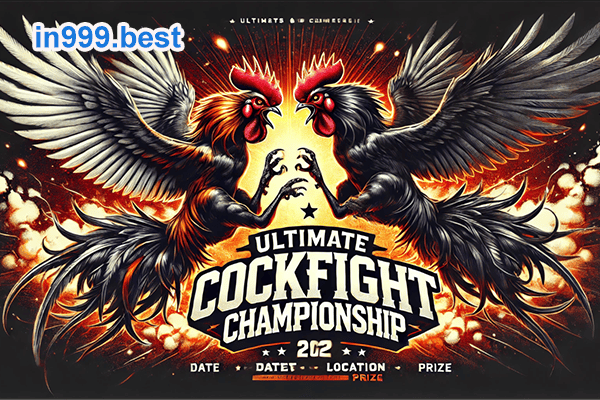Introduction to Cock Fight
cock fight is an ancient blood sport where two specially trained roosters battle in an enclosed ring. This tradition has been part of various cultures for centuries, often associated with gambling and entertainment. While some consider a fighting match a significant cultural tradition, others strongly oppose it due to ethical concerns regarding animal welfare.

Even in regions where laws prohibit the cock fight, underground events continue to attract participants and spectators. This article of in999 explores the history, traditions, regulations, and controversies surrounding this practice.
The History and Cultural Significance of Cock Fight
Ancient Origins
The cock fight has been practiced for over 3,000 years, with records of its existence in Asia, Greece, Rome, and the Middle East. It has historically been more than just a form of entertainment—it has often symbolized strength, bravery, and even spirituality.
India & China: The earliest documentation suggests a fighting match was linked to fortune and religious rituals.
Greece & Rome: Warriors believed watching a fighting match before the battle could inspire courage.
Medieval Europe: The aristocracy hosted a fighting match as a grand spectacle for the elite.
Global Spread of Cock Fight
As European explorers traveled, they introduced the cock fight to Latin America, the Caribbean, and Southeast Asia. In countries such as Mexico, Puerto Rico, and the Philippines, a fighting match evolved into a structured sport, complete with official arenas and formalized betting systems.
Even today, a fighting match remains an attraction in certain regions, particularly during festivals and community celebrations.
How a Cock Fight Works: Rules, Training, and Betting
Breeding and Training
Not all roosters are suited for a cock fight. Only breeds known for their aggression, endurance, and strength are selected. Some of the most recognized breeds include:
Asil (India): Known for its resilience and powerful strikes.
Shamo (Japan): A tall and muscular breed with a strong attack ability.
Thai Gamecock (Thailand): Agile and strategic in combat.

Preparation for a Cock Fight
Roosters selected for a cock fight undergo extensive conditioning before competing. Their training includes:
Sparring exercises to enhance endurance.
A specialized diet rich in protein for muscle development.
Strength and agility drills to improve speed and maneuverability.
Structure of a Cock Fight
Each fighting match follows a specific format to ensure fairness and competitiveness:
Pairing of Opponents: Roosters are matched based on weight class.
Pre-Fight Preparations: In some locations, artificial spurs or blades are attached to their legs.
The Battle Begins: The birds are released into the ring to engage in combat.
Declaring the Winner: The fighting match ends when one rooster is unable to continue.
Betting in a Cock Fight
Gambling plays a significant role in a cock fight, with different betting options available:
Head-to-Head Bets: Spectators place wagers on the expected winner.
Side Bets: Additional wagers focus on match duration and combat techniques.
Legal Status of Fighting Match Worldwide
Where Cock Fight is Legal
Some countries recognize the fighting match as part of their cultural heritage and regulate it accordingly:
The Philippines: Sabong, the local term for a match, operates under government regulation.
Mexico & Puerto Rico: Government-licensed arenas host fighting matches.
Thailand & Indonesia: Traditional fighting match events are permitted with specific guidelines.
Where Cock Fight is Illegal
Many nations have prohibited the fighting match due to ethical concerns:
United States & Canada: Strict laws penalize anyone involved in organizing a fighting match.
United Kingdom & Australia: Heavy fines and legal consequences for participating in a fighting match.
European Union: Most EU countries impose bans and severe penalties for violations.
Despite legal restrictions, illegal underground matches remain widespread, often tied to gambling networks.
The Ethical Debate: Cultural Tradition vs. Animal Rights
Arguments Supporting fighting match
Proponents argue that the fight match should be preserved for the following reasons:
It is a cultural tradition with historical significance.
It generates economic benefits, supporting breeders, trainers, and local businesses.
It is a competitive sport, much like other combat-based contests.
Arguments Against Cock Fight
Animal rights organizations oppose the fighting match, citing:
Severe cruelty, as roosters suffer fatal injuries.
Encouragement of illegal gambling, often linked to criminal activity.
Forced animal aggression, raising ethical concerns about treatment.
Organizations such as PETA and the Humane Society actively campaign for stricter bans and stronger law enforcement against the fighting match.
The Future of This Sport
With growing concerns over animal welfare, the future of the fighting match remains uncertain. Some countries continue enforcing stricter bans, while others regulate the activity rather than eliminating it entirely.
Potential Alternatives to Cock Fight
Non-lethal competitions: Roosters compete without dangerous weapons, reducing injuries.
Virtual simulations: A fighting match recreated through digital platforms, eliminating harm to real animals.
Supporters argue that modernizing the fighting match could make it more ethical, while critics believe the practice will eventually disappear due to shifting perspectives.
Conclusion
The cock fight has been a controversial tradition for centuries. While some countries defend it as an integral cultural activity, others view it as an outdated and inhumane practice. As awareness of animal rights grows, many governments are tightening restrictions to either control or eliminate the match.
Understanding the history, regulations, and ethical debates surrounding the cock fight helps in forming an informed perspective on whether the practice should continue, evolve, or be completely abolished.
